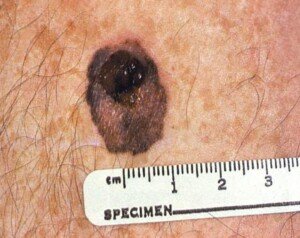
You may not know as much as you think you do when it comes to melanoma screening and just what to look for during your self-skin exams. Here are guidelines.
According to melanoma expert George Hollenberg, MD, a dermatopathology specialist in Plainview, NY:
“Rates continue to increase with age and are highest among those in their 80s, but melanoma is one of the more common cancers in young adults.”
It’s not common in the absolute sense, but relative to other cancers such as colon, lung and prostate, melanoma indeed is one of the more common malignancies in people in their 20s and 30s.
Dr. Hollenberg is the former medical director of Accupath Labs, and in that position had overseen the analysis of thousands of skin biopsies every year.
He is a veteran of pathology and dermapathology; and has concentrated expertise in unusual moles and skin cancer.
Dr. Hollenberg urges that everybody should get screened for melanoma, and adds: “Unlike many other common cancers, melanoma has a wide age distribution.”
Minimizing the Risk of Melanoma in All Age Groups
1 If you can, avoid sun exposure between 10 a.m. and 4 p.m.
2 Wear sunscreen every day that protects against UVA and UVB rays.
3 Wear a wide brimmed hat.
4 Avoid tanning beds. They are not safer than the sun, and in fact, emit more potent rays than the sun does.
Risk Factors for Melanoma
Risk factors, other than the obvious of spending a lot of time in the sun or using tanning beds, include a childhood history of at least one sunburn, having many moles, unusual moles, fair skin, family history of melanoma, and a weak immune system.

Melanoma. CDC, Carl Washington, MD, Emory Univ. School of Medicine, Mona Saraiya, MD, MPH
When you screen yourself for melanoma, Dr. Hollenberg says to follow the ABCDE plan.
Asymmetry: An irregular, uneven shape; one half the lesion different from the other half.
Border: Jagged or blurry edges.
Color: Various colors, often multicolored lesions of tan, dark brown, or black, sometimes pink or red, blue or white.
Diameter: 6 millimeters or larger (about the size of a pencil eraser).
Evolution: Any change in size, color, or appearance.

“The most important warning sign of melanoma is a new or changing skin lesion, regardless of its size or color, particularly if changes occur over a short period of time,” Dr. Hollenberg says.
Biopsy is the only way to rule out this most deadly of skin cancers with 100 percent conclusiveness.
A dermatologist cannot simply look at your skin, even with a handheld lens, and say with 100 percent conviction, “This isn’t melanoma.”
Regardless of your age or skin color, every time you get your routine physical, ask your doctor to screen you for melanoma, in addition to having monthly self-skin exams.
Dr. Hollenberg passed away in 2013.
 Lorra Garrick has been covering medical, fitness and cybersecurity topics for many years, having written thousands of articles for print magazines and websites, including as a ghostwriter. She’s also a former ACE-certified personal trainer.
Lorra Garrick has been covering medical, fitness and cybersecurity topics for many years, having written thousands of articles for print magazines and websites, including as a ghostwriter. She’s also a former ACE-certified personal trainer.
.








































